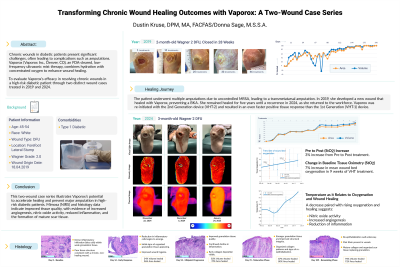Case Series/Study
(CS-075) Transforming Chronic Wound Healing Outcomes with Vaporous Hyperoxia Therapy (VHT®): A Two-wound Case Series

Methods: To evaluate VHT’s efficacy in resolving chronic wounds in a high-risk diabetic patient through two distinct wound cases treated in 2019 and 2024.
Methods:
A 51-year-old Caucasian female with type 1 diabetes (HbA1c 7.8, historically well-controlled) and a history of anemia presented with chronic wounds resistant to standard treatments. In 2019, she had a Wagner Grade 2 diabetic foot ulcer (DFU) on a forefoot stump following a trans metatarsal amputation (TMA). Standard care, including negative pressure wound therapy, skin grafts, and other advanced therapies, failed to achieve closure. In 2024, the same patient developed a new DFU on the right foot, which worsened under initial treatment with collagen, Medi honey, and topical antibiotics. Healing progress was monitored using advanced imaging techniques such as Near-Infrared Spectroscopy (NIRS) and thermography imaging.
Results:
Wound #1 (2019): At VHT initiation, the wound measured 1.4 x 1.6 x 0.3 cm with an area of 2.24 cm² and volume of 0.672 cm³. After 4 weeks, the wound achieved a 45.98% reduction in area and a 64.88% reduction in volume. By 8 weeks, the wound showed a 64.29% reduction in area and a 76.19% reduction in volume, ultimately achieving 100% resolution after 46 treatments over 28 weeks
Wound #2 (2024): Initially measured 1.2 x 1.9 x 0.5 cm with bioburden and pale granulation tissue. After 4 weeks of VHT®, the wound achieved a 56.6% reduction in area and a 74.0% reduction in volume. At 7 weeks, the wound showed an 89.5% reduction in volume, measuring 0.6 x 1.0 x 0.2 cm, and is on track to fully resolve with continued treatment.
At baseline (day zero), a temperature gradient was observed between the wound and periwound areas, suggestive of a potential infection. The mean tissue oxygenation at the wound bed was 90% ± 14%, with a hypoxic area present (St2 < 39%). Following four weeks of treatment, the temperature gradient persisted, though wound bed oxygenation improved to 91% ± 11%, and the hypoxic area was no longer detectable. By six weeks, both the temperature gradient and hypoxic area had resolved, indicating positive healing trajectory.
Discussion:
These cases highlight VHT’s transformative potential in reversing chronic wound deterioration in complex diabetic cases. For this patient, who previously experienced treatment failures, VHT facilitated remarkable healing outcomes.

.jpg)